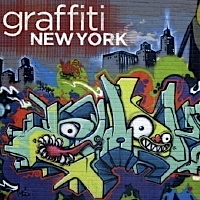|
Concrete jungle New York is where hard-knock life subsists. The one that relegated punk musicians to SoHo when it was less than inhabitable. The drug transactions just blocks off Central Park at the Douglas housing projects on Columbus Street, or the New York that relinquished its ties with the soiled ambivalent souls that should be institutionalized.
If anything characterizes New York's urban culture since the '70s, it's the art form of graffiti that rose from the rubble and social disparities. Graffiti, which dates back to ancient Pompeii and Rome, even back then interestingly carried the same sociopolitical message that proliferated the modern version. Graffiti's roots in New York are profound and graffiti historian, Eric Felisbret has set out to chronicle the stories of the amazing art in his new book, Graffiti New York (Abrams).
Descending into the cavernous subway access off of 72nd Street, across the street from The Dakota, where John Lennon was assassinated and Yoko Ono still lives, facing Central Park, of course, decay and debris has replaced the graffiti that was once ubiquitously published on subway cars.
The rigorous eradication of graffiti became a priority for mayor Giuliani in the late '90s. They figured the Broken Windows theory would apply to the lawlessness of tagging. This became a trying time for the dying art form, since the repercussions were high and people started talking about jail time.
Midweek, Felisbret agrees to tour an area of Queens called,Ê5 Pointz, known worldwide for its lawful tagging. The enormous edifice seems to sit alone in this crowded street block, as the kaleidoscope of colors explode onto the subway car.
Felisbret and his brother, Luke, quickly beeline out of the subway car and viscerally plunge downstairs from the raised train tracks. The train's metal shriek takes over the atmosphere until it disappears into the distance.
|
 |

LINKS:
@149st
@149st (Myspace)
|
|
"The interesting thing about 5 Pointz, it doesn't only draw traditional graffiti artist, it draws other people that work in the same medium of spray paint," says Felisbret. A blast of color lettering, portraits, and caricatures engulf the building.
Universally, graffiti is linked to hip-hop as a brother that secured the four elements onto history. "People always talk about the four elements of hip-hop: graffiti, b-boying, DJ'ing, and MC'ing, and that's something that was fabricated long after graffiti has sorta established itself. Graffiti was a mature art form way before the other elements," explains Felisbret.
Luke glides into the exchange: "Some of my rock 'n' roll friends, they're upset with the issue, their history, their culture is being overshadowed by another aspect of New York City culture. They don't hate hip-hop culture, they just want an equal face..."
During its infancy, graffiti was driven by music. All music, it was never selective. From the tropical sounds of salsa to the guitars of the rock 'n' roll. "Black Sabbath and Led Zeppelin, to me, became synonymous with graffiti," Luke continues. And that's because rock 'n' rollers would tag the lyrics of these groups on subway cars, way before hip-hop.
Graffiti has a hierarchy, an expansive timeline, and assorted styles, difficult to pinpoint to non-artists. Felisbret's book articulates on deciphering the beautiful art.
Above us, several slow-moving trains forge forward, the screech reminding us we are in New York.
The influence of graffiti is felt throughout New York. From Times Square to the windows of Macy's that showcase a white dinner table bursting in graffiti, this art form sometimes flirts with mainstream America. Now, graffiti showcased in a gallery? That's a different game, all together.
"It loses its organic quality, it's kinda like putting an animal into a zoo, you know, it's fun to look at, it's something wild but it's not the same as going to a wild environment and seeing it in its natural habitat," says Luke. In order for graffiti to be raw and historic, it needs to remain illegal ("they like the adrenaline of climbing over a fence and running from the authority," says Luke).
Trekking back, the sea of yellow cabs seem to float, affected by the current of the uneven Manhattan streets. A disheveled, leggy model waves down a cab, eagerly wanting to seal herself in it. She is wearing a pair of white Converse that read, GRAFFITI NYC. The irony. END
|